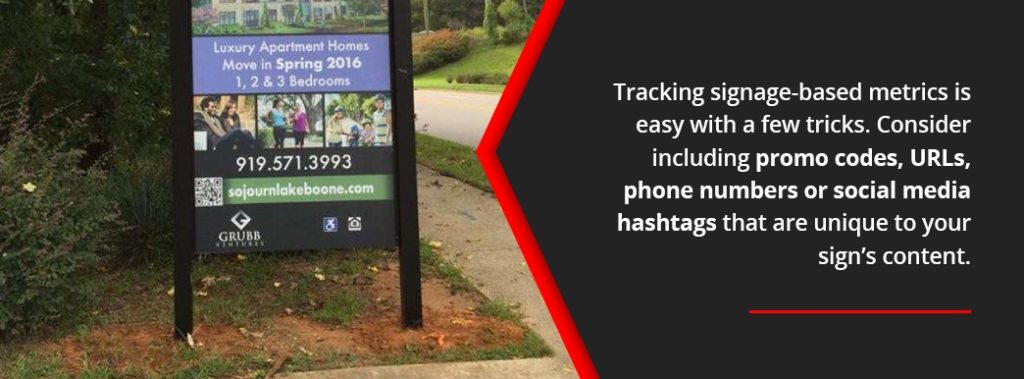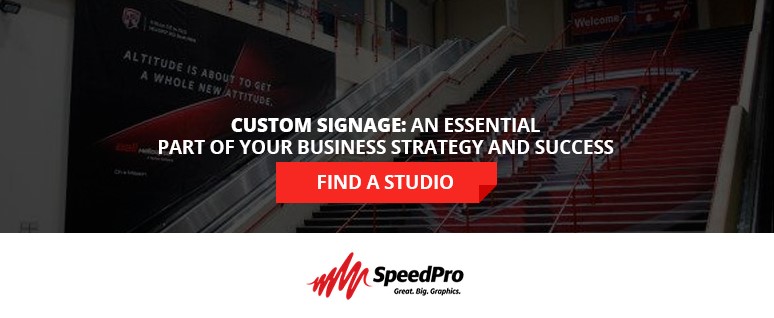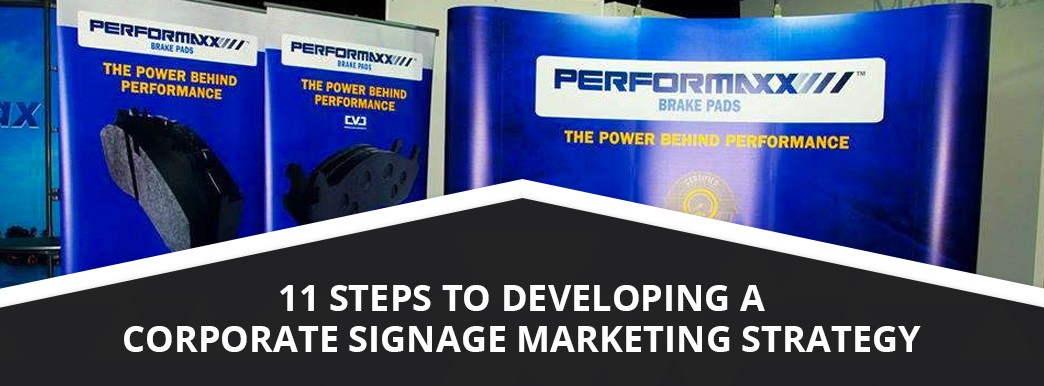
11 Steps to Developing a Corporate Signage Marketing Strategy
MARCH 29, 2019| SpeedProCategories
SignageCreating marketing campaigns is a core aspect of running a business. Creating marketing campaigns that stand out from the pack, make lasting connections with target customers and drive traffic to you both in-store and online? Now that’s a marketer’s utopia.
Signage is one of the ways you can take your marketing strategy to the next level and position your brand for success. To craft successful signage, learn more about how corporate signage impacts marketing and the steps you can take to develop stronger graphics and signage.
How Does Signage Impact Marketing?
A marketing strategy refers to outlining messages and methods to distinguish your goods and services from others in the industry. When implemented among an audience, marketing strategies help shape your business’ core identity, ultimately positioning it for greater market share.
In other words, corporate marketing strategy identifies who you are and what you’re about, then strategizes the best ways to share that identity with target consumers.
Signage marketing is when physical signs are incorporated into a company’s overall marketing strategy. Coordinated to match and enhance other marketing collateral, signage becomes a central way to showcase your brand. And because SpeedPro studios have the tools and technology to produce dozens of sign types with hundreds of features and customizations, your corporate signage stands to be as unique as your business, capturing the full nature of your brand.
Take advantage of the additional benefits of corporate signage’s impact, which go beyond a beautified, on-brand storefront:
- Captivate new clients: Sign graphics don’t just hang in front of storefronts anymore. Companies transform their branded signs into stickers, decals, wall murals, architectural glass, backlit graphics, contour-cut signs, point-of-purchase displays, banners and so much more. These materials are printed and placed beyond a business’ walls too. Expand your customer base using strategically designed signs stationed in attention-grabbing spaces, widening the breadth and depth of your company’s advertising efforts.
- Re-engage established customers: Influence the very customers who were instrumental to your past success — but in fresh, surprising and innovative ways. Display new products or services, advertise consumer-related events, unveil a revamped logo or have fun with core advertising messages. Whatever techniques keep your target audience feeling connected to your company and your products or services are winners in an overall corporate marketing strategy.
- Employ innovative marketing tactics: Signs can be interactive and experiential. Advances in digital signs mean you can utilize user-generated content, displaying photos or videos created by the public but shared by your brand on your signs. Your business can go one step further by generating branded hashtags, starting social media giveaways and sponsoring competitions where winners take home a free product or service — all because they performed a behavior or action incentivized by your signs.
- Grow and reinforce your brand: Corporate branding is essential to getting people to know your company and trust you as their go-to source for whatever service or product you provide. The text you place on your signage can reflect your brand voice, helping viewers become familiar with your tone and core message. Additionally, signage can come in colors and designs that match your brand, making it so your audience instantly identifies the signs and graphics as yours.
You likely already create and use corporate signs. Most companies are familiar with signage for directional or wayfinding purposes or to advertise time-sensitive events like seasonal sales and limited-time-only deals. Others may have utilized similar large-format graphics in the past to capture eyes and foot traffic alike, though only for ad-hoc campaigns.
Break from the mold with corporate signage incorporated into your overall marketing strategy. Sharpen the words, images and themes you want to be associated with. Put forward a consistent brand template harmonizing all company collateral, regardless of departmental, office or branch origins. Such cohesion elevates the professionalism of your branded signs and signals that your business knows what it’s doing both today and tomorrow.
Signage Design Ideas
Whether you’re a brand new business looking to develop your first corporate signage marketing strategy, or you’re an established company moving into its next chapter in marketing efforts, SpeedPro can help guide you through key signage design points to make the most of your vision. First, consider the range of sign types available:
- Wall murals brand the sides of buildings, turning brick and mortar into a marketer’s canvas. Murals can be interior or exterior, greeting guests as they step into a corporate lobby and lending a colorful backdrop to shelved merchandise. They can also be installed on the outside of your storefront to attract passing eyes.
- A-frames and fabric sidewalk signs are popular choices for reaching customers right where they are — on the streets. Branded sidewalk signs can be worked into an overall signage marketing strategy, set up at public and industry events alike to showcase your business consistently.
- Foam boards are an ideal choice for standing or easel displays at trade shows, conferences, meetings and similar industry events. They offer a consistent way to showcase new products and services, announce company events, highlight recent industry awards and press, or simply display a company name and logo proudly wherever you’d like.
- Floor or sidewalk graphics are surprising twists on classic marketing signage. Vinyl-substrate stickers and decals make it as easy as peeling and placing custom floor graphics onto tile, concrete, asphalt, wood and more. Graphics can be quirky and conversational to conservative yet consumer-focused, stamping a mark on your space.
- Digital signage takes screens from static, passive points of display to engaging and highly customizable extensions of your core marketing materials. Businesses utilize digital signage for everything from showcasing menus and special event promotions to making internal company announcements and greeting customers in comfortable reception areas.
- Custom marketing flags offer flashy, highly visible products that are lightweight, mobile and — most of all — attention-grabbing. Pick from feather, blade, teardrop and more flag shapes and sizes to design a unique array of corporate signs fitting any indoor or outdoor environment.
- Point-of-purchase (POP) displays can be more than small, run-of-the-mill shelves placed next to your cash register. When they’re strategically designed, POP displays can align with the same brand imagery and personality of your business. Crafting POP displays with marketing care directly sways purchasing behavior, literally boosting sales with style.
- Event graphics excel at tradeshows, expos and similar B2B and B2C industry events. Showcase your products and services in eye-catching, engaging ways through brand-aligned table covers and table toppers, backdrops, banners and even experiential event graphics.
- Step and repeat banners are backdrops containing your name, business logo and branded color scheme. People will enjoy taking pictures and snapping selfies in front of the branded backdrop. For extra marketing momentum, create a step-and-repeat banner hashtag that participants can share on social media along with their photos. Incentivize photo shares with a product giveaway, store discount or branded merchandise, then watch the marketing momentum unfold.
Steps to Developing a Corporate Signage Marketing Strategy
Moving the needle toward achieving your business’ prominence and sales goals requires time and effort. An authentic corporate signage strategy will give you the right footing, leveraging a familiar item in multifaceted marketing material with measurable impact.
Launch your corporate signage marketing strategy today by planning, preparing and adhering to the following steps — then start seeing results unfold tomorrow.
1. Know Your Why
Companies must have a unique purpose for creating their desired range of display graphics. This purpose must be clear and concise but also targeted, complementing the overall “personality” you want your company to be known for.
In other words, corporate signage must be compatible with your actual growth goals and overall corporate identity. Without focused marketing funneled into your business’ core identity, any branding effort will turn shapeless.
Remember to chisel that “why” into one or two clear marketing purposes, not a list. Otherwise, your corporate signs risk trying to do everything and anything — boost brand awareness, showcase products and services, advertise events, spotlight news, grow social media followings, be funny, informative, pithy and professional — all at once. When signs try to do everything, they end up doing nothing.
2. Do Your Research
What do competitors’ signs look like? Where are they placed? What colors, images, shapes and materials do they use? Does a glance or two get their brand message across, telling you exactly who they are and what they’re about?
Corporate signage must distinguish a company from its competition. Making your marketing signs bigger and placing them higher isn’t necessarily the answer either. Instead, conduct thorough industry research to cross your T’s and dot your I’s, generating signage design ideas that holistically stand apart from the crowd.
This process is especially important if your signage will be installed or placed near competitors’, a distinct possibility both at industry events (like product expos) and around your own storefront, where other shops or businesses surely compete for traffic.
Thorough research also includes looking into city codes and ensuring that any signs you do place outside follow sidewalk or street regulations. For more on sign compliance, see the information under both the “Banners” and “Signs” sections of SpeedPro’s FAQ Resource Center.
3. Define Successful Outcomes
All marketing initiatives require key performance indicators, or KPIs, for tracking. KPIs provide the quantitative data to prove the success or growth areas of your current marketing efforts, and they point out insights on what to try.
Interestingly enough, CMOs in one of 2018-2019’s largest marketing industry surveys cited brand awareness as the most important marketing metric they track — even more important than data like customer value and marketing channel ROI. A signage marketing strategy directly aligns — and amplifies — brand awareness.
4. Align the Medium With the Message — and the Sign’s Goal
Remember step one — know your why. Pick sign types that best showcase your why — i.e., the precise product, service or message you wish to highlight. Ensure the design of that sign or graphics display supports the message, conveying the right tone and personality to make your business even more memorable.
5. Rope in Stakeholders
Once you have the goal, marketing metrics and sign types outlined for your corporate signage strategy, you can move on to including key stakeholders in the initiative.
Consult employees and department leaders alike on the mission behind fresh branded signs. How does more cohesive corporate signage benefit them or help with their work? When you position corporate initiatives — like a signage marketing strategy — to match real people’s everyday roles, you establish these initiatives’ relevance and increase the likelihood of holistic buy-in.
6. Understand Your Brand
Your sign marketing strategy should be tied directly to your brand strategy. How are you trying to get other people to see your company? What image do you want your audience to have of you? Your corporate branding strategies should be reflected in the signage you choose. Before you design your signage, establish the core elements of your brand.
The best brand positioning strategies center around choosing a consistent voice for their company while also selecting colors and designs that consumers can identify quickly as your company’s. When you know your brand, your signage will capture the essence of your company and reflect that essence back out to the world, drawing people in with an attractive brand personality they can connect with.
As you begin designing your signage, you’ll want to ensure you have a handle on these three elements of corporate branding:
- Brand imaging: There are likely going to be emblems, patterns and symbols associated with your brand, showing up in your products and marketing materials. As such, identify the imagery you consistently use and implement it in your signage to reflect your company better.
- Brand logos: You likely have a corporate logo that you use on your company materials, such as paperwork, physical merchandise, company uniforms, product packaging and your website. This logo makes a statement about your business and is a key identifier of your brand. Make sure you know what your logo is and incorporate it into your signage.
- Brand color schemes: Color is crucial to any brand. Usually, businesses choose one to three colors to use in their marketing materials, helping to improve brand recall. You’ll want to ensure your signage incorporates these colors into the sign and that the signage studio you work with has the color-matching technology to print signage in your exact colors.
7. Develop a Design Template
Design templates are the core aesthetic of all signage. Whether a business is printing flags, event banners, window decals, wall murals, POP displays or anything in between, signage design templates ensure all collateral remains cohesive and goal-oriented.
SpeedPro’s own network of staffed designers can assist you in developing a branded sign template, or you can pass along your own vision and details. Signage design templates should, at a minimum, contain the following:
- Font(s)
- Color schemes
- Backgrounds or backdrops (solid color, pattern, picture/image, etc.)
- Business information (to include on all signs regardless of type)
8. Set a Rollout Schedule
Determine when you want your new signage printed and installed. Leave enough room in the rollout schedule for initial design drafts, edits, printer vetting, consultations and final sign fabrication, plus plenty of time to rope in stakeholders and gain approval at every stage.
Signage rollout schedules should be complementary to any other marketing or sales campaigns underway. This rule ensures that company-wide efforts to increase brand awareness and boost sales remain structured for effectiveness and success, not fighting for resources.
9. Track Performance Metrics
Measure and record the KPIs you identified in step three. You can assign one metric stakeholder or an entire team to measuring the effectiveness of your signage marketing strategy, then pivot tomorrow’s decisions to reflect insights you learned today.
Tracking signage-based metrics is easy with a few tricks. Consider including promo codes, URLs, phone numbers or social media hashtags that are unique to your sign’s content. Upticks in their prevalence will show that your signs are indeed capturing attention and nurturing strategic behaviors.
10. Calculate ROIs
Calculating your signage’s return on investment is beneficial for a number of reasons.
First, it furthers your case to company stakeholders that signs are high-visibility and high-impact, reaching target consumers even amidst today’s ad-saturated environment.
Second, it helps determine smarter budgets. Companies that track ROIs can allocate resources more carefully quarter-by-quarter and year-by-year, assured their hard-earned money is spent where it’ll go the furthest.
Finally, calculating ROIs is simply a keen business management practice. Companies shirking return-on-investment calculations are missing out on a crucial KPI with internal and external persuasive power. Few other benchmarks prove that your business is putting its money where its mouth is — and reaping the rewards.
11. Tweak and Tailor
Corporate signage isn’t static. Contrary to what many people tend to think, signs shouldn’t be showing the same images and messages or highlighting the same goods and services over a long period. Repeat exposure to identical material will turn your signs into white noise in the eyes — and minds — of your target customers.
Tweaking and tailoring your corporate signage means treating signs like what they are: a strategy — living, learning and developing. Business strategies cannot thrive on ad-hoc or unplanned schedules. Static signage won’t capture the same attention or drive the same results as their fluid counterparts. Fresh signage campaigns:
- Help customers upgrade their purchase, buying in increased quantities or values
- Persuade customers to see your brand in a new light
- Drive greater foot traffic and in-store interactions
- Encourage audiences to connect with the business on multiple channels, expanding your physical and digital footprint
Custom Signage: An Essential Part of Your Business Strategy and Success
At SpeedPro, we provide end-to-end corporate marketing signage services to boost your branding from passing to powerhouse, allowing you to reap strategic business benefits along the way. Our nationwide network of visual communications studios means a printing partner is right around the corner, ready to bring your signage ideas to life.
Find your local SpeedPro studio and request a signage quote to get started.

















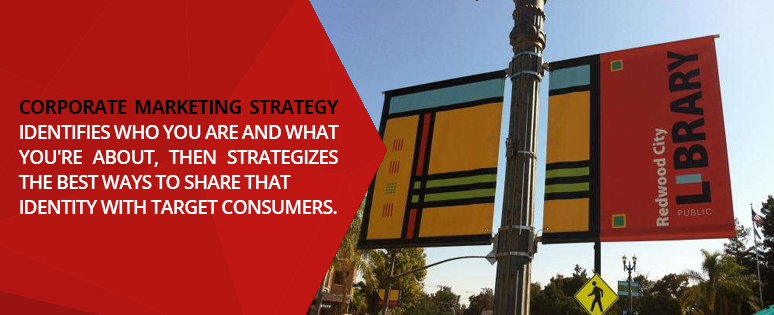
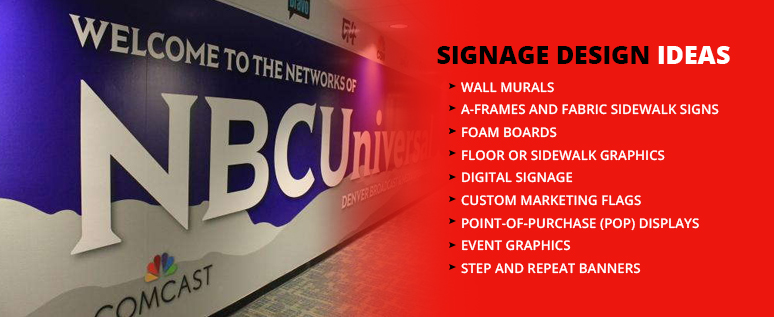
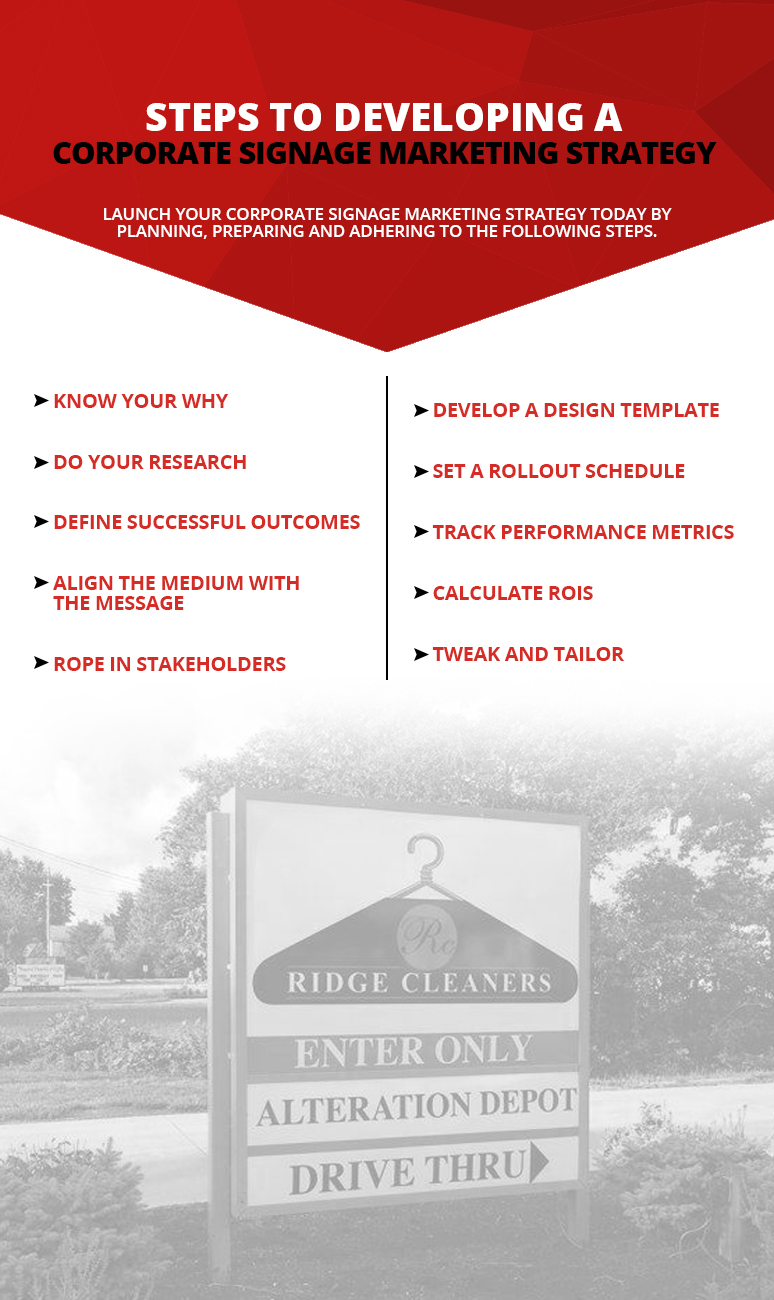
![Three main elements of corporate branding [list]](https://www.speedpro.com/wp-content/uploads/2020/06/uc-1024x379.jpg)
